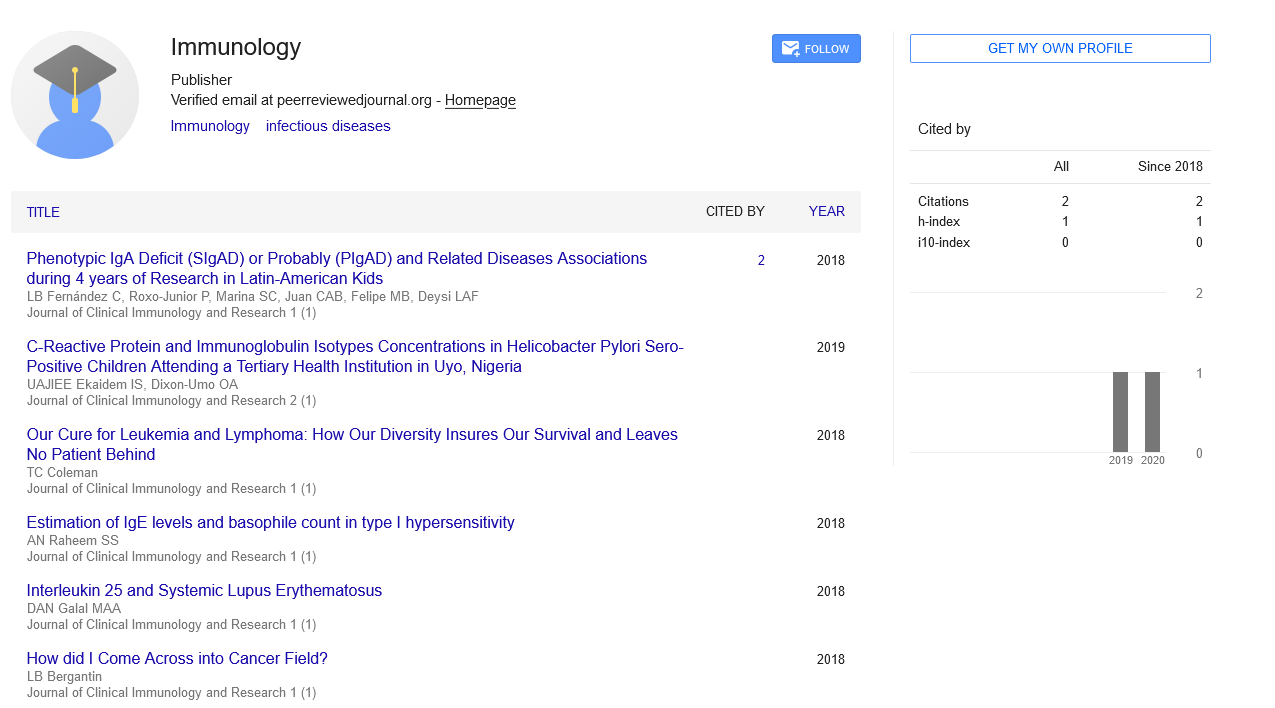Editorial, J Clin Immunol Res Vol: 3 Issue: 1
Impact in the pathology and clinical highlights
Chiguang Feng*
Department of Microbiology and Immunology, University of Maryland School of Medicine, Maryland, USA
*Corresponding Author : Chiguang Feng
Department of Microbiology and Immunology, University of Maryland School of Medicine, Maryland, USA
E-mail: cfeng@som.umaryland.edu
Received: April 02, 2020 Accepted: April 17, 2020 Published: April 24, 2020
Citation: Feng C (2020) Impact in the pathology and clinical highlights. J Clin Immunol Res 3:1. doi: 10.37532/jcir.2020.3(1).e102
Editorial
Clinical immunology is the investigation of ailments brought about by abnormal activity, and dangerous development of the cell components. It additionally includes infections that have an impact in the pathology and clinical highlights. The most notable sickness that influences the resistant framework itself is AIDS, an immunodeficiency portrayed by the concealment of CD4+ ("assistant") T cells, dendritic cells and macrophages by the Human Immunodeficiency Virus (HIV).
As one of the Editors of the Editorial board, I would like to express my experience as I am associated with the journal for the past two years. Journal mainly focuses on the research in Immunology and immune deficiency diseases, covering all the research areas of Cancer Immunotherapy, Contagious diseases, Neuroimmunology, Vaccine Immunology, HIV, T-cell Immunology, Microbial Immunology, etc.
Immunology covers the study of immune systems in all organisms. Immunology charts, measures, and contextualizes the physiological functioning of the immune system in states of both health and diseases; malfunctions of the immune system in immunological disorders (such as autoimmune diseases, hypersensitivities, immune deficiency, and transplant rejection); and the physical, chemical, and physiological characteristics of the components of the immune system in vitro, in situ, and in vivo. Immunology has applications in numerous disciplines of medicine, particularly in the fields of organ transplantation, oncology, rheumatology, virology, bacteriology, parasitology, psychiatry, and dermatology.
Prior to the designation of immunity, from the etymological root immunes, which is Latin for "exempt", early physicians characterized organs that would later be proven as essential components of the immune system. The important lymphoid organs of the immune system are the thymus, bone marrow, and chief lymphatic tissues such as spleen, tonsils, lymph vessels, lymph nodes, adenoids, and liver. When health conditions worsen to emergency status, portions of immune system organs, including the thymus, spleen, bone marrow, lymph nodes, and other lymphatic tissues, can be surgically excised for examination while patients are still alive. Many components of the immune system are typically cellular in nature and not associated with any specific organ, but rather are embedded or circulating in various tissues located throughout the body.
Maternal factors also play a role in the body’s immune response. At birth, most of the immunoglobulin present is maternal IgG. Because IgM, IgD, IgE and IgA don't cross the placenta, they are almost undetectable at birth. Some IgA is provided by breast milk. These passively-acquired antibodies can protect the newborn for up to 18 months, but their response is usually short-lived and of low affinity. These antibodies can also produce a negative response. If a child is exposed to the antibody for a particular antigen before being exposed to the antigen itself then the child will produce a dampened response. Passively acquired maternal antibodies can suppress the antibody response to active immunization. Similarly, the response of T-cells to vaccination differs in children compared to adults, and vaccines that induce Th1 responses in adults do not readily elicit these same responses in neonates. Between six and nine months after birth, a child ’ s immune system begins to respond more strongly to glycoproteins, but there is usually no marked improvement in their response to polysaccharides until they are at least one year old. This can be the reason for distinct time frames found in vaccination schedules.
The journal attracts a world-wide readership. Contributions from all over the world are greatly welcomed. The journal publishes peerreviewed original research, authoritative reviews, well-balanced commentary on significant articles, and expert opinion on new techniques and technology.
Journal of Clinical Immunology Research Started in the year 2018 and got support from the contributors as well as the subscribers. Journal continues to publish new research on all aspects of Immunology. However, the editors are keenly aware that in certain fields such as Infectious diseases and are anxious to make good such deficiencies and invite the submission both of reports on personal research and of wide-ranging surveys. The encouragement of appropriate submissions is one of the main responsibilities of the Advisory Editorial Board, and appointments to it have always been made with a view to increasing involvement in the Journal.
 Spanish
Spanish  Chinese
Chinese  Russian
Russian  German
German  French
French  Japanese
Japanese  Portuguese
Portuguese  Hindi
Hindi 